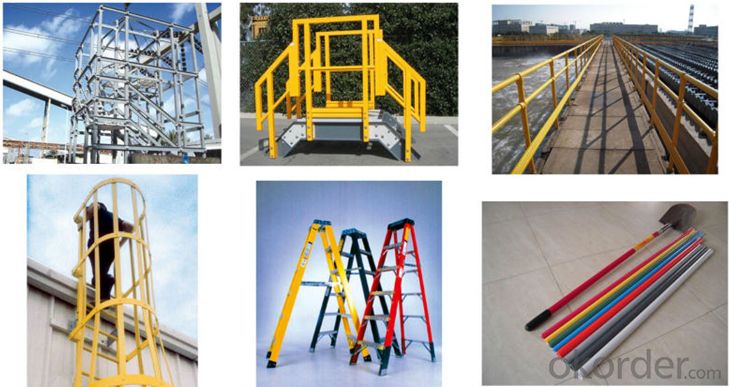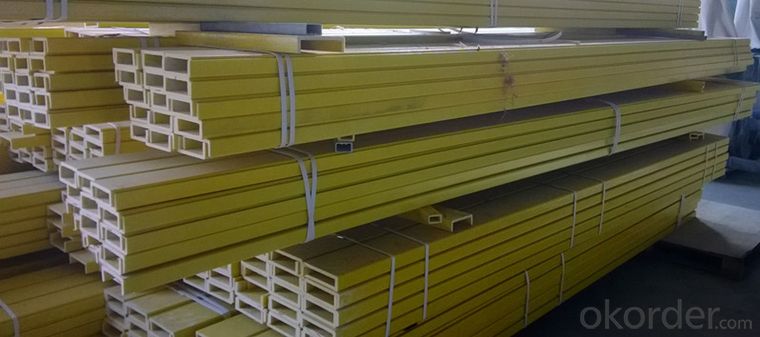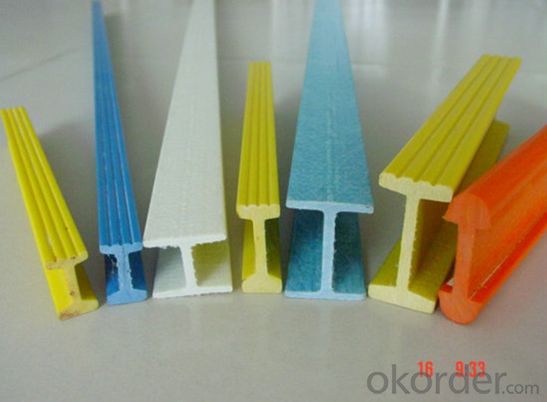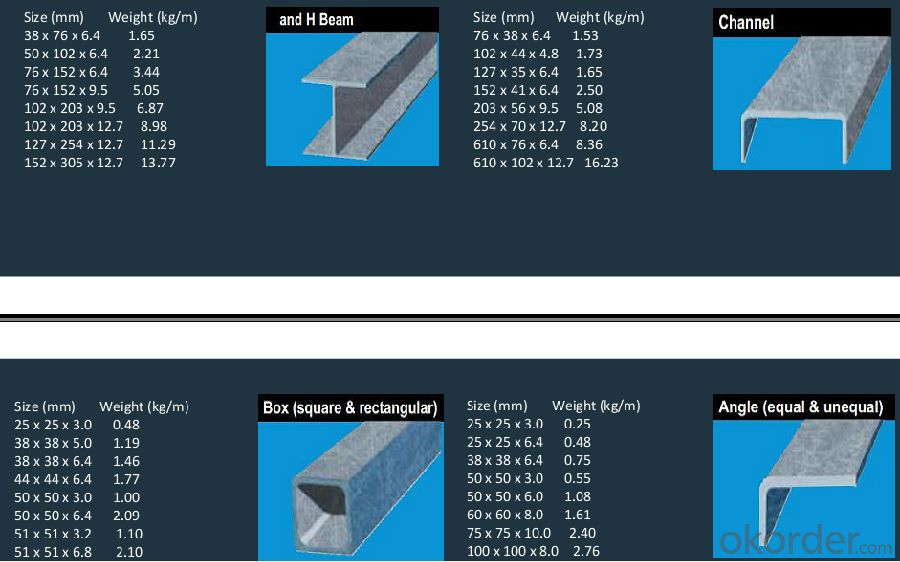FRP Beam
- Loading Port:
- Shanghai
- Payment Terms:
- TT OR LC
- Min Order Qty:
- -
- Supply Capability:
- 20000m m.t./month
OKorder Service Pledge
Quality Product, Order Online Tracking, Timely Delivery
OKorder Financial Service
Credit Rating, Credit Services, Credit Purchasing
You Might Also Like
Specifications
fiberglass mesh grating
1.meet ASTM E-84 AND ISO9001
2.anti-corrosion floor
3.anti-conductive
4.walkway,platform,trench cove
fiberglass mesh grating
Corrosion and Chemical resistant;Slip-resistant ;High strength-to-weight ratio;Ergonomic ;Low maintenance ;Fire retardant ;Easily fabricated and installed




- Q:Are FRP pultrusion profiles resistant to alkaline substances?
- Yes, FRP pultrusion profiles are generally resistant to alkaline substances. The use of fiberglass reinforced polymer (FRP) in pultruded profiles provides excellent resistance to a wide range of chemicals, including alkaline substances. The resin used in the manufacturing process is typically a thermosetting polymer, such as polyester or vinyl ester, which offers high resistance to alkaline solutions. Moreover, the reinforcement of fiberglass imparts additional strength and durability to the profiles, making them highly resistant to corrosion and degradation from alkaline substances. However, it is important to note that the specific resistance of FRP pultrusion profiles to alkaline substances may vary depending on the specific resin formulation and manufacturing process. Therefore, it is recommended to consult with the manufacturer or supplier to ensure the profiles meet the desired resistance requirements for specific alkaline environments.
- Q:What types of materials are commonly used in FRP pultrusion?
- Fiber Reinforced Polymer (FRP) pultrusion is a manufacturing process that involves pulling continuous fibers through a resin bath and then through a heated die, resulting in a composite material with high strength and stiffness. Various types of materials are commonly used in FRP pultrusion, depending on the specific application and desired properties. 1. Fibers: The most commonly used fibers in FRP pultrusion are fiberglass (glass-reinforced polymer) and carbon fibers. Fiberglass is cost-effective, lightweight, and offers good strength and corrosion resistance. Carbon fibers, on the other hand, provide exceptional strength, stiffness, and lightweight properties but are more expensive. 2. Resins: The resin matrix used in FRP pultrusion provides the material with rigidity and protection against environmental factors. Polyester resin is the most common resin used due to its low cost, ease of handling, and good mechanical properties. Vinyl ester resin is another popular choice, offering improved chemical resistance and heat tolerance compared to polyester. Epoxy resin is used when high strength and durability are required. 3. Additives: Various additives can be incorporated into the resin matrix to enhance specific properties of the FRP pultruded product. UV stabilizers are commonly used to protect against ultraviolet degradation. Flame retardants can be added to increase fire resistance. Other additives like pigments, fillers, and mold release agents may also be used to achieve desired aesthetics and processing characteristics. By selecting the appropriate combination of fibers, resins, and additives, FRP pultrusion can produce a wide range of composite materials with tailored properties to meet specific application requirements. This versatility in material selection is one of the key advantages of FRP pultrusion, making it suitable for a variety of industries such as construction, infrastructure, aerospace, automotive, and marine.
- Q:Can FRP pultrusion profiles be used in electrical insulation applications?
- Yes, FRP pultrusion profiles can be used in electrical insulation applications. FRP (Fiber Reinforced Polymer) materials have excellent electrical insulation properties, making them suitable for a wide range of electrical applications. The pultrusion process ensures that the profiles have uniform insulation properties and high strength, making them ideal for use in electrical insulation applications.
- Q:How do FRP pultrusion profiles perform in extreme heat temperatures?
- FRP pultrusion profiles are renowned for their exceptional performance in extreme heat conditions. The profiles acquire remarkable heat resistance properties due to the distinct combination of materials utilized in the pultrusion process, such as fiberglass reinforcement and thermosetting resin matrix. One of the primary benefits of FRP pultrusion profiles lies in their capacity to uphold dimensional stability even when subjected to elevated temperatures. Unlike conventional materials like steel or aluminum, which may expand or deform under extreme heat, FRP profiles retain their shape and structural integrity. Consequently, they offer a high level of reliability in applications where temperature fluctuations are frequent or where exposure to intense heat is prevalent. Furthermore, FRP pultrusion profiles possess exceptional thermal insulation properties. They possess a low thermal conductivity, effectively impeding heat transfer. This characteristic proves advantageous in situations where heat control or isolation is necessary, preventing the profiles from becoming excessively hot. Moreover, FRP pultrusion profiles boast a high heat distortion temperature (HDT). HDT refers to the temperature at which a material begins to deform under a specific load. Typically, the HDT of FRP profiles surpasses that of other materials, enabling them to endure extreme heat without compromising their structural integrity. In conclusion, FRP pultrusion profiles are highly suitable for use in extreme heat conditions. Their ability to maintain dimensional stability, resist heat transfer, and withstand high temperatures renders them a dependable choice for diverse industries, including aerospace, automotive, and infrastructure.
- Q:Do FRP pultrusion profiles have any limitations or drawbacks?
- Yes, FRP pultrusion profiles do have certain limitations and drawbacks. One limitation is that FRP pultrusion profiles have lower stiffness compared to traditional materials like steel or aluminum. This means that they may not be suitable for applications that require high structural rigidity or heavy loads. Another limitation is that FRP pultrusion profiles are prone to creep, which is the gradual deformation of the material under a constant load over time. This can negatively affect the long-term performance and durability of the profiles, especially in applications where they are subjected to sustained stress. Additionally, FRP pultrusion profiles are generally more expensive to produce compared to traditional materials. The manufacturing process involves pultruding continuous fibers through a resin matrix, which requires specialized equipment and expertise. This can result in higher production costs, making FRP pultrusion profiles less cost-effective for certain applications. Furthermore, FRP pultrusion profiles are generally not suitable for high-temperature applications. The resin matrix used in their production can degrade or soften at elevated temperatures, limiting their use in environments where thermal resistance is critical. Lastly, FRP pultrusion profiles may have limited design flexibility compared to other materials. The pultrusion process typically produces profiles with constant cross-sections and limited geometric complexity. This can restrict their use in applications that require intricate shapes or customized designs. Despite these limitations and drawbacks, FRP pultrusion profiles offer several advantages such as high strength-to-weight ratio, corrosion resistance, and electrical insulation properties. It is important to carefully consider the specific requirements of the application before opting for FRP pultrusion profiles.
- Q:Can FRP pultrusion profiles be used in the mining and mineral processing industry?
- Yes, FRP (Fiber Reinforced Polymer) pultrusion profiles can be used in the mining and mineral processing industry. FRP pultrusion profiles have several properties that make them suitable for use in this industry. Firstly, FRP pultrusion profiles are lightweight yet incredibly strong. This makes them ideal for applications where weight reduction is important, such as in mining equipment or processing plants. Despite their lightweight nature, FRP profiles can withstand heavy loads and resist corrosion, which is particularly beneficial in the mining industry where equipment is exposed to harsh environments and corrosive substances. Secondly, FRP pultrusion profiles are non-conductive and possess excellent electrical insulation properties. This is advantageous in mining and mineral processing operations where electrical safety is paramount. FRP profiles can be used in applications where electrical conductivity needs to be avoided, such as in electrical enclosures or cable trays. Additionally, FRP pultrusion profiles are highly resistant to chemicals, including acids and alkalis. This makes them suitable for use in mineral processing plants where various corrosive chemicals are used in the extraction and processing of minerals. FRP profiles can withstand exposure to these chemicals without deteriorating or experiencing significant damage, prolonging their lifespan and reducing maintenance costs. Furthermore, FRP pultrusion profiles have a high strength-to-weight ratio, which means they can be used to create durable and lightweight structures. This is particularly beneficial in mining operations where structures such as walkways, ladders, and platforms need to be installed in challenging terrains. The lightweight nature of FRP profiles makes them easier to transport, handle, and install compared to traditional materials like steel. In conclusion, FRP pultrusion profiles can be effectively used in the mining and mineral processing industry due to their lightweight, high strength, corrosion resistance, electrical insulation, and chemical resistance properties. These profiles offer numerous advantages over traditional materials, making them a viable option for various applications in this industry.
- Q:Can FRP pultrusion profiles be used in infrastructure projects?
- Yes, FRP pultrusion profiles can be used in infrastructure projects. These profiles are lightweight, durable, and corrosion-resistant, making them ideal for applications in bridges, walkways, railings, and other structural components. They offer high strength-to-weight ratios and can be customized to meet specific project requirements. Additionally, FRP pultrusion profiles are non-conductive, making them suitable for electrical infrastructure projects.
- Q:Can FRP pultrusion profiles be used in mining applications?
- Yes, FRP (Fiber Reinforced Plastic) pultrusion profiles can be used in mining applications. FRP pultrusion profiles are known for their high strength-to-weight ratio, corrosion resistance, and durability, making them well-suited for various mining applications. In mining operations, FRP pultrusion profiles can be used for a range of purposes. They can be used for structural support in underground mines, such as in the construction of tunnels, shafts, and mine roofs. Their high strength allows them to withstand heavy loads and provide long-term support. FRP pultrusion profiles can also be used for equipment and machinery support, such as in conveyor systems, pumps, and tanks. Their resistance to corrosion makes them suitable for use in harsh mining environments, where exposure to moisture, chemicals, and abrasive materials is common. Furthermore, FRP pultrusion profiles can be used for safety applications in mining, including handrails, walkways, and grating systems. These profiles can provide reliable and non-slip surfaces, ensuring the safety of workers in mining operations. Overall, FRP pultrusion profiles offer several advantages in mining applications, including their high strength, corrosion resistance, durability, and ease of installation. These qualities make them a viable and cost-effective choice for various mining operations, contributing to improved efficiency and safety in the industry.
- Q:Can FRP pultrusion profiles be used in the construction of theme park rides?
- Yes, FRP pultrusion profiles can be used in the construction of theme park rides. FRP (Fiber Reinforced Polymer) pultrusion profiles are known for their high strength-to-weight ratio, corrosion resistance, and durability, making them suitable for various structural applications. These profiles can be used to build ride components such as supports, beams, frames, and safety structures, providing a lightweight yet robust solution for theme park rides.
- Q:Are FRP pultrusion profiles resistant to hydrocarbons?
- Yes, FRP (Fiber Reinforced Polymer) pultrusion profiles are generally resistant to hydrocarbons. The combination of various reinforcing fibers such as fiberglass or carbon fiber with a polymer matrix makes FRP materials highly resistant to chemical corrosion, including hydrocarbons. This resistance makes FRP pultrusion profiles a suitable choice for applications where exposure to hydrocarbons is expected, such as in oil and gas industry, chemical processing plants, or fuel storage facilities. However, it is important to note that the level of resistance can vary depending on the specific type of resin used in the FRP material and the concentration and temperature of the hydrocarbons involved. Therefore, it is recommended to consult with the manufacturer or supplier of the FRP pultrusion profiles to ensure their compatibility with the specific hydrocarbon environment in question.
1. Manufacturer Overview |
|
|---|---|
| Location | |
| Year Established | |
| Annual Output Value | |
| Main Markets | |
| Company Certifications | |
2. Manufacturer Certificates |
|
|---|---|
| a) Certification Name | |
| Range | |
| Reference | |
| Validity Period | |
3. Manufacturer Capability |
|
|---|---|
| a)Trade Capacity | |
| Nearest Port | |
| Export Percentage | |
| No.of Employees in Trade Department | |
| Language Spoken: | |
| b)Factory Information | |
| Factory Size: | |
| No. of Production Lines | |
| Contract Manufacturing | |
| Product Price Range | |
Send your message to us
FRP Beam
- Loading Port:
- Shanghai
- Payment Terms:
- TT OR LC
- Min Order Qty:
- -
- Supply Capability:
- 20000m m.t./month
OKorder Service Pledge
Quality Product, Order Online Tracking, Timely Delivery
OKorder Financial Service
Credit Rating, Credit Services, Credit Purchasing
Similar products
New products
Hot products
Related keywords




























